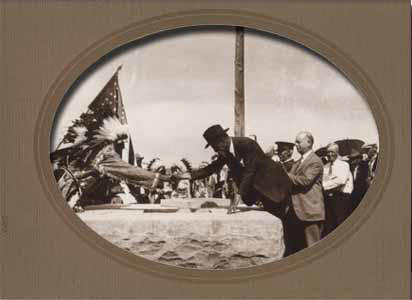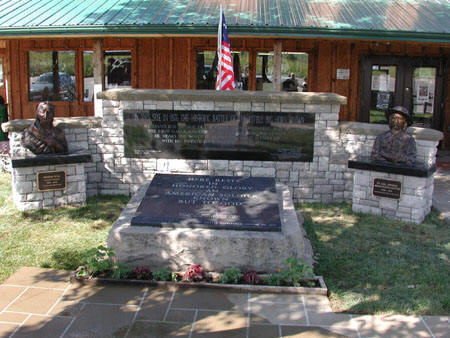|

Where the Battle of the Little Bighorn began
- Sitting Bull's Camp in 1876
The town
of Garryowen was named after the old Irish tune
"Garry Owen" which was one of Lt. Col. George
Armstrong Custer's favorite marching songs.
"Garry Owen" is an old Irish quick-step that can
be traced back to the 1800s. it is known to have
been used by Irish regiments as a drinking song.
So the story goes, one of the Irish "melting
pot" members of the 7th Cavalry was singing the
song under the influence of spirits, and Custer
happened by, liked the rhythm, and soon began to
hum the tune. Garryowen is derived from Gaelic
meaning Owen's garden, which is a suburb of
Limerick, Ireland. The tune has a fast paced and
lively beat. The song was adopted as the
regimental song soon after Custer arrived to
take over the 7th Cavalry. It was the last song
played by the band for Custer's men as they left
the Terry column at the Rosebud River and rode
into history.
50th Anniversary of the Battle of the Little Bighorn
 Burying
of the Hatchet, White Bull a Sioux Indian Chief,
and General Edward Godfrey bury the hatchet in
the grave of the Unknown Soldier at Garryowen,
Montana. It was near this sight that Custer
divided his forces and began his attack against
Sioux, Arapahoe and Cheyenne that were camped
within the valley of the Little Bighorn. Burying
of the Hatchet, White Bull a Sioux Indian Chief,
and General Edward Godfrey bury the hatchet in
the grave of the Unknown Soldier at Garryowen,
Montana. It was near this sight that Custer
divided his forces and began his attack against
Sioux, Arapahoe and Cheyenne that were camped
within the valley of the Little Bighorn.
A registered historic site, Garryowen, the only
town within the Battlefield is located at I-90
Exit 514 just south of the Little Bighorn
Battlefield National Monument and Custer
National Cemetery. The site is just one hour's
drive from Billings, Montana or from Sheridan,
Wyoming. The Battle of the Little Bighorn began
on this quiet riverbank when 7th Cavalry troops
attacked Sitting Bull's camp in the first
military action of the West's most famous
battle. This grassy riverbank is where Major
Marcus Reno's troops attacked Sitting Bull's
camp on the afternoon of June 25th, 1876 under
Lt. Col. George A. Custer's command. For a
century the battle was known as "Custer's Last
Stand" or the "Custer Massacre."
From Garryowen, visitors can view all of the
famous locations associated with the Battle of
the Little Bighorn, including the site where
Custer was last seen alive, Major Reno's hilltop
defense site, Weir Point, Last Stand Hill,
Medicine Tail Coulee, the Crow's Nest, and Wolf
Mountains.
 The
Tomb of the Unknown Soldier is the burial site
of one of the first casualties of the Battle of
the Little Bighorn. The granite tomb was
dedicated during the Burial of the Hatchet
Ceremony in 1926 at Garryowen, during the 50th
Anniversary of the Battle of the Little Bighorn
after the discovery of the Unknown Soldiers body
when building the interstate. White Bull Sioux
Indian, and General Godfrey performed the
ceremony in front of 50,000 observers. The
Granite "Peace Memorial" behind the Tomb was
dedicated on the 125th Anniversary of the Battle
of the Little Bighorn. The
Tomb of the Unknown Soldier is the burial site
of one of the first casualties of the Battle of
the Little Bighorn. The granite tomb was
dedicated during the Burial of the Hatchet
Ceremony in 1926 at Garryowen, during the 50th
Anniversary of the Battle of the Little Bighorn
after the discovery of the Unknown Soldiers body
when building the interstate. White Bull Sioux
Indian, and General Godfrey performed the
ceremony in front of 50,000 observers. The
Granite "Peace Memorial" behind the Tomb was
dedicated on the 125th Anniversary of the Battle
of the Little Bighorn.
The town is now privately owned and operated by
Christopher Kortlander. It is the site of the
Custer Battlefield Museum, a Federal Post Office, Conoco Gas Station,
convenience store, Subway sandwich shop,
Historical Rarities and rest area.
The Custer Battlefield Museum houses extensive
new exhibits including hundreds of Custer
Battlefield artifacts from the Battle of the
Little Bighorn and the Plains Indian War
period.
Documentaries are shown hourly in the theatre
adjacent to the museum and give logistical
battle bearings to visitors before they begin
the historical voyage through the Museum, then
move on to the Little Bighorn Battlefield.
Important Indian War period artifacts and
manuscripts related to Custer, Crazy Horse,
Sitting Bull, and the 7th Cavalry, as well as an
acclaimed collection of highly historic
photographs by D.F. Barry, are part of the
exhibit. Preserved, for example, is the
contract for Sitting Bull's appearance in the
famous Buffalo Bill Wild West Show. This is the
only contract signed by Sitting Bull known to
exist.
The exhibit area houses a lock of Custer's Hair,
Captain Tom W. Custer's Kerr revolver, Little
Wolf's battle-worn eagle feather war bonnet, war
clubs and trade knives, cavalry spurs and a U.S.
Cavalry pistol dropped on the Reno retreat route
- still fully loaded.
Significant collection of battle vintage beaded
clothing on exhibit adds to bronzes, paintings,
and other memorabilia to create an educational
tour through the vanished American frontier.
For tourist and lodging information about
Garryowen please feel free to call 406-638-1876.
|



 The
Tomb of the Unknown Soldier is the burial site
of one of the first casualties of the Battle of
the Little Bighorn. The granite tomb was
dedicated during the Burial of the Hatchet
Ceremony in 1926 at Garryowen, during the 50th
Anniversary of the Battle of the Little Bighorn
after the discovery of the Unknown Soldiers body
when building the interstate. White Bull Sioux
Indian, and General Godfrey performed the
ceremony in front of 50,000 observers. The
Granite "Peace Memorial" behind the Tomb was
dedicated on the 125th Anniversary of the Battle
of the Little Bighorn.
The
Tomb of the Unknown Soldier is the burial site
of one of the first casualties of the Battle of
the Little Bighorn. The granite tomb was
dedicated during the Burial of the Hatchet
Ceremony in 1926 at Garryowen, during the 50th
Anniversary of the Battle of the Little Bighorn
after the discovery of the Unknown Soldiers body
when building the interstate. White Bull Sioux
Indian, and General Godfrey performed the
ceremony in front of 50,000 observers. The
Granite "Peace Memorial" behind the Tomb was
dedicated on the 125th Anniversary of the Battle
of the Little Bighorn.